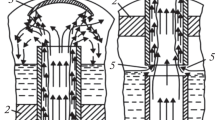Abstract—
A mathematical model describing the desorption of dissolved oxygen from superheated water when it enters the rarefaction zone is proposed. The initial model was obtained proceeding from a thermodynamic approach as a result of solving the material balance equations for the components of the considered “water–water vapor–gas” system taking into account the phase transition in the liquid. Further development of the model for taking into account the nonequilibrium nature of the processes occurring in the system was carried out using the methods of the heat and mass transfer processes similarity theory and regression analysis involving experimental data on various types of deaeration devices. Based on the results from a statistical analysis of alternative models, including the well-known model describing the deaeration of water when it enters into vacuum jet-bubbling deaerators, the choice of the final mathematical model is substantiated. Using this makes it possible to calculate the deaeration effect under the considered conditions depending on the initial water superheating with respect to the saturation temperature in the rarefaction zone, the deaeration element hydraulic load, and static pressure in it. It has been found that the obtained mathematical description is able to generalize, with acceptable accuracy, the experimental information on structurally different deaeration elements operating when superheated water is injected into them: droplet, centrifugal-vortex, cavitation-jet, and vacuum-cavitation ones. The obtained model can be used in designing new and improving the performance efficiency of existing deaeration plants at thermal power plants and industrial enterprises. As part of the study, the model was tested in solving problems concerned with operational adjustment of a cavitation-jet deaerator and for substantiating the technical solutions on upgrading the jet deaerator by topping it with a deaeration device operating under superheated water conditions.







Similar content being viewed by others

REFERENCES
V. I. Sharapov and D. V. Tsyura, Thermal Deaerators (Ul’yanovskii Gos. Tekh. Univ, Ul’yanovsk, 2003) [in Russian].
A. G. Shempelev and P. V. Iglin, “Causes of the increased oxygen content in condensate of steam turbine installations,” Nadezhnost Bezop. Energ., No. 4, 61–64 (2015).
G. V. Ledukhovskii, Yu. E. Barochkin, V. P. Zhukov, V. N. Vinogradov, and I. A. Shatova, “Water deaeration in water-cooling systems of the stator winding in a turbogenerator with hydrogen-water cooling,” Therm. Eng. 65, 751–755 (2018). https://doi.org/10.1134/S004060151810004X
Yu. M. Kostrikin, N. A. Meshcherskii, and O. V. Korovina, Water Treatment and Water Chemistry of Power-Engineering Objects of Low and Medium Pressure (Energoatomizdat, Moscow, 1990) [in Russian].
I. I. Oliker and V. A. Permyakov, Thermal Deaeration of Water at Thermal Power Plants (Energiya, Leningrad, 1971) [in Russian].
Z. M. Adzhiev, “Deaerator ‘AVAKS’,” RF Patent No. 2246446, Byull. Izobret., No. 5 (2005).
V. I. Sharapov and V. E. Makarova, “On direct-flow vacuum deaerators,” Energosberezhenie Vodopodgot., No. 3, 42–44 (2006).
B. A. Zimin, “Problems of water deaeration in power engineering and their solution,” Nov. Teplosnabzh., No. 1, 40–44 (2006).
A. A. Kudinov, S. K. Ziganshina, N. V. Borisova, and G. I. Shamshurina, “Study of operating modes of vacuum-cavitation deaerators at Samara State District Power Plant,” Elektr. Stn., No. 2, 38–42 (2011).
A. A. Kudinov and S. K. Ziganshina, “Vacuum-cavitation deaerator of Samara State District Power Plant,” Vestn. SGASU, Gradostroit. Arkhit., No. 3 (16), 96–102 (2014).
R. Sh. Abiev, M. P. Vasil’ev, and V. A. Doil’nitsyn, “Study of the process of vacuum degassing of water in a vortex jet apparatus,” Izv. SPbGTI (TU), No. 28 (54), 64–69 (2015).
G. V. Ledukhovskii, A. N. Roslyakov, V. N. Vinogradov, V. P. Zhukov, and E. V. Barochkin, “Empirical support for the mathematical model of water deaeration in the centrifugal-vortex deaerators,” Vestn. IGEU, No. 5, 5–10 (2015). https://doi.org/10.17588/2072-2672.2015.5.005-010
G. V. Ledukhovskii, Yu. E. Barochkin, V. N. Vinogradov, and A. E. Barochkin, “Increasing the efficiency of technological systems of heat power stations by using cavitation deaerating devices,” Vestn. IGEU, No. 1, 5–13 (2018). https://doi.org/10.17588/2072-2672.2018.1.005-013
S. S. Kutateladze, Heat Transfer in Condensation and Boiling, 2nd ed. (Mashgiz, Moscow, 1952; U.S. Atomic Energy Commission, Technical Information Service, Washington, DC, 1959).
E. Guyon, J.-P. Hulin, L. Petit, and C. D. Mitescu, Physical Hydrodynamics (Oxford Univ. Press, Oxford, 2015).
J. Heinhold, Ingenieur-Statistik (Springer-Verlag, München, 1964).
G. V. Ledukhovskii, V. P. Zhukov, and Yu. E. Barochkin, “Simulation of thermal water deaeration based on a matrix approach to the design of heat-and-mass exchangers,” Therm. Eng. 66, 287–292 (2019). https://doi.org/10.1134/S0040601519040050
E. V. Barochkin, V. P. Zhukov, G. V. Ledukhovskii, and A. A. Borisov, “Generalized method for calculating multistage deaerators,” Izv. Vyssh. Uchebn. Zaved., Khim. Khim. Tekhnol. 47 (9), 100–103 (2004).
Author information
Authors and Affiliations
Corresponding author
Additional information
Translated by V. Filatov
Rights and permissions
About this article
Cite this article
Ledukhovsky, G.V., Zhukov, V.P., Barochkin, Y.E. et al. Modeling the Dissolved Oxygen Desorption when Superheated Water Enters the Rarefaction Zone. Therm. Eng. 68, 570–576 (2021). https://doi.org/10.1134/S0040601521050074
Received:
Revised:
Accepted:
Published:
Issue Date:
DOI: https://doi.org/10.1134/S0040601521050074



